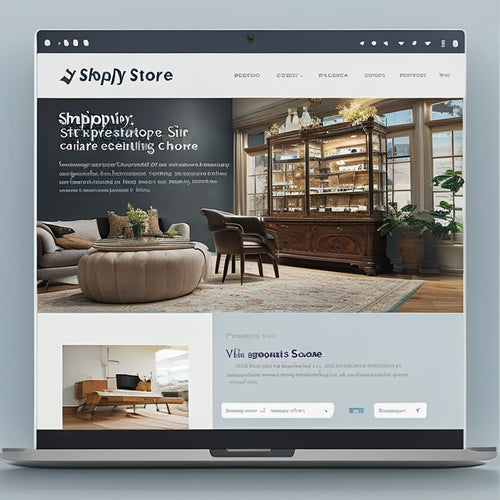
10 Essential Data Analytics Tools for Online Stores
Share
You need a robust set of data analytics tools to drive your online store's success. Start with Google Analytics for Ecommerce to track sales and revenue. Then, utilize customer behavior analysis software and product performance monitoring tools to identify areas for improvement. Abandoned cart analysis platforms and customer segmentation analytics tools help you optimize the customer journey. Supply chain optimization software and inventory management analytics tools streamline your operations. Finally, maximize your return on ad spend analysis to get the most out of your marketing budget. With these essential tools, you'll be well on your way to data-driven decision making - and that's just the beginning.
Key Takeaways
• Online stores need analytics tools to track sales, revenue, and customer behavior to optimize their business strategy and improve performance.
• Google Analytics is essential for ecommerce tracking, providing insights into customer interactions and conversion rates.
• Sales and revenue tracking tools like Mixpanel, ChartMogul, and Baremetrics help monitor product performance and identify areas for improvement.
• Inventory management analytics tools and supply chain optimization software ensure efficient product management and minimize stockouts or overstocking.
• Return on Ad Spend analysis and competitor analysis software help online stores optimize their marketing strategies and stay ahead of the competition.
Google Analytics for Ecommerce
You can leverage Google Analytics for ecommerce to gain a deeper understanding of your online store's performance, from tracking sales and revenue to monitoring customer behavior and identifying areas for improvement.
By integrating Google Analytics into your ecommerce platform, you'll have access to a wealth of data that can inform your business decisions. Conducting traffic analysis, for instance, will help you understand how customers are finding your site, which channels are driving the most traffic, and where users are dropping off. This information allows you to optimize your marketing strategies and improve your website's user experience.
Additionally, Google Analytics provides insights into user engagement, including metrics such as bounce rate, pages per session, and average session duration. These metrics help you identify areas where users are struggling and make data-driven decisions to enhance their experience.
With Google Analytics, you'll be able to pinpoint opportunities to increase conversions, reduce cart abandonment, and drive more sales.
Sales and Revenue Tracking Tools
Accurate sales and revenue tracking is essential for online stores, as it enables data-driven decisions that drive business growth, and a range of tools are available to help ecommerce businesses achieve this goal.
You need to monitor your sales and revenue performance to refine your marketing strategies, identify opportunities, and optimize your operations. With the right tools, you can track your sales and revenue in real-time, analyze trends, and gain insights into customer behavior.
Tools like Mixpanel, ChartMogul, and Baremetrics provide you with a comprehensive view of your sales and revenue performance. You can track metrics such as customer lifetime value, average order value, and revenue growth rate. This data enables you to identify areas for improvement, optimize your pricing strategies, and develop effective customer retention plans.
Customer Behavior Analysis Software
By leveraging customer behavior analysis software, ecommerce businesses can uncover hidden patterns and trends in customer interactions, ultimately driving more informed product development, marketing, and customer experience strategies. This type of software provides you with a deeper understanding of your customers' online behavior, helping you identify areas of improvement and opportunities for growth.
With user engagement analysis, you can track how customers interact with your website, identifying pain points and areas of high engagement. This information can be used to optimize your site's user experience, increasing conversions and reducing bounce rates.
Additionally, purchase pattern tracking enables you to analyze customers' buying habits, identifying popular products, frequently bought together items, and shopping cart abandonment rates. This data can be used to inform product recommendations, promotions, and loyalty programs.
Product Performance Monitoring Tools
To gain a thorough understanding of product performance, ecommerce businesses utilize product performance monitoring tools that track key metrics, such as sales, revenue, and inventory levels, in real-time. These tools provide you with actionable insights to optimize your product offerings, ensuring you stay ahead of the competition.
With product performance monitoring tools, you can:
-
Analyze sales trends: Identify top-selling products, track sales velocity, and forecast future sales to inform your inventory management and pricing strategies.
-
Optimize pricing strategies: Analyze competitor pricing, track price elasticity, and identify opportunities to adjust prices for maximum revenue and profit.
-
Streamline inventory management: Monitor inventory levels, track stockouts, and receive alerts when it's time to restock, ensuring you never miss a sale due to stockouts.
Abandoned Cart Analysis Platforms
You can access valuable insights into your customers' behavior with abandoned cart analysis platforms, which help you identify and tackle the root causes of cart abandonment, ultimately increasing conversion rates and revenue.
These platforms provide you with detailed analytics on cart abandonment rates, identifying patterns and trends that inform your cart recovery strategies.
By understanding why customers abandon their carts, you can develop targeted customer engagement tactics to re-engage them and encourage completion of their purchases.
Abandoned cart analysis platforms also enable you to implement email retargeting campaigns, sending personalized messages to customers who've abandoned their carts.
Behavioral targeting strategies can be employed to tailor your messaging and offers to individual customers based on their browsing and purchase history.
By leveraging these insights, you can create effective cart recovery strategies that resonate with your customers and drive conversions.
With abandoned cart analysis platforms, you can optimize your checkout process, improve customer satisfaction, and boost revenue.
Conversion Rate Optimization Tools
Having optimized your cart recovery strategies, it's now time to focus on fine-tuning your entire conversion funnel with conversion rate optimization tools. These tools help you identify areas of improvement, allowing you to maximize your online store's revenue potential.
Here are three essential conversion rate optimization tools you should consider:
-
A/B testing tools: Leverage A/B testing strategies to experiment with different versions of your website, identifying which ones drive higher conversions. This could be anything from tweaking button colors to rewriting product descriptions.
-
Website heatmaps and session recording tools: Visualize your customers' behavior with website heatmaps, revealing areas of friction and opportunity. This data helps you optimize user experience and streamline the customer journey.
-
Customer journey mapping tools: Map out your customers' entire journey, from initial interaction to final purchase. This helps you identify pain points, opportunities for improvement, and areas where you can enhance the overall user experience.
Customer Segmentation Analytics Tools
By segmenting your customers into distinct groups based on their behaviors, preferences, and demographics, you can create targeted marketing campaigns that resonate with each audience. Customer segmentation analytics tools help you do just that. These tools analyze large datasets to identify patterns and trends, enabling you to categorize customers into specific segments.
Demographic segmentation, for instance, groups customers based on age, gender, location, and income level. Behavioral targeting, on the other hand, focuses on customers' online activities, such as browsing history and purchase behavior.
With customer segmentation analytics tools, you can create highly targeted marketing campaigns that speak directly to each segment's needs and preferences. This leads to increased engagement, conversion rates, and ultimately, revenue growth. You can also use these tools to identify high-value customer segments, optimize pricing strategies, and develop effective loyalty programs.
Supply Chain Optimization Software
Over 70% of online retailers struggle with inefficient supply chain management, leading to delayed shipments, lost sales, and damaged brand reputation, which is where supply chain optimization software comes in.
As an online store owner, you need to streamline your supply chain operations to stay competitive. Supply chain optimization software helps you achieve this by providing real-time visibility into your inventory, shipping, and logistics operations.
With this software, you can:
-
Optimize demand forecasting: Accurately predict customer demand to make certain you have the right products in stock, reducing stockouts and overstocking.
-
Enhance supplier collaboration: Collaborate with suppliers in real-time, securing timely deliveries and reducing supply chain disruptions.
-
Analyze logistics performance: Track and analyze your logistics operations to pinpoint bottlenecks and areas for improvement.
Inventory Management Analytics Tools
You regularly face inventory-related challenges, such as stockouts, overstocking, and dead stock, which can greatly impact your online store's bottom line and customer satisfaction. To overcome these hurdles, you need robust inventory management analytics tools that provide real-time insights into your stock levels, demand patterns, and sales trends.
These tools enable you to optimize your inventory levels, reduce waste, and improve your overall supply chain efficiency.
With advanced analytics capabilities, you can analyze sales data to identify patterns and trends, enabling you to make informed decisions about pricing strategies and sales forecasting. You can also use these tools to monitor product life cycles, track inventory movement, and identify opportunities to clearance slow-moving items.
Return on Ad Spend Analysis
To maximize the effectiveness of your online store's marketing efforts, analyzing the return on ad spend (ROAS) is essential to understand which advertising channels generate the highest revenue and optimize your ad budget allocation.
By calculating ROAS, you can identify areas of improvement in your marketing strategy.
Here are three key aspects to focus on:
-
Ad targeting analysis: Analyze your target audience's demographics, interests, and behaviors to make sure your ads are reaching the right people.
-
Attribution modeling: Determine which touchpoints in the customer journey are contributing to conversions, so you can distribute your ad spend more effectively.
-
Marketing ROI calculation: Calculate the return on investment for each marketing channel to pinpoint areas of positive ROI and optimize your ad spend accordingly.
Frequently Asked Questions
Can I Use Data Analytics Tools With My Existing Ecommerce Platform?
You can integrate data analytics tools with your existing ecommerce platform, ensuring platform compatibility, and gaining valuable data insights. Look for tools with seamless integration options and a user-friendly interface to maximize your results.
How Often Should I Review and Update My Analytics Tool Setup?
"You're likely aware that 60% of businesses fail to effectively utilize their data analytics tools. To avoid this, you should review and update your analytics tool setup quarterly, ensuring alignment with evolving data analytics methodologies and adjusting frequency of updates to optimize insights."
Are Data Analytics Tools Compatible With Mobile Apps?
You'll find that most data analytics tools offer mobile app tracking, ensuring seamless integration and data accuracy. When choosing a tool, verify its mobile app compatibility to guarantee precise insights into your mobile user behavior.
Can I Integrate Analytics Tools With My Customer Relationship Management System?
You're probably drowning in data, but integrating analytics tools with your CRM system is a game-changer! You'll access customer insights, informing marketing strategies, and streamline data analysis to optimize your online store's performance.
Do I Need Technical Expertise to Use Ecommerce Data Analytics Tools?
You don't need to be a tech whiz to use ecommerce data analytics tools, as many offer user-friendly interfaces and extensive training resources, allowing you to delve into and start analyzing your online store's performance.
Related Posts
-
Boost Sales And Engagement With Reactive Video Commerce
Reactive Video Commerce offers businesses an innovative solution to boost sales and engagement. By incorporating shop...
-

3 Best Ecommerce Scaling Strategies for Rapid Growth
You're stuck in neutral if your ecommerce business isn't scaling rapidly, and it's likely due to inefficient operatio...
-

Can Shopify Generate a Sitemap
This article examines the capability of Shopify to generate a sitemap. It discusses the potential benefits of using ...

